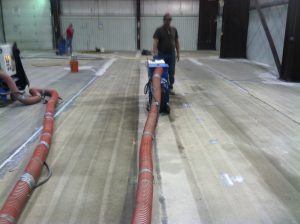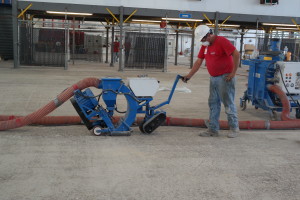The proper surface preparation procedure for concrete is easily one of the most discussed – and debated – subjects in the coatings industry. There are many different perspectives on what constitutes proper concrete preparation techniques. Some in the industry see surface preparation as a budget item that can be skimped on, or even skipped entirely. However, time and time again, this viewpoint has been proven to be false. Proper concrete surface prep is critical to the success of epoxy floor coatings. It is a step in the process that deserves a significant investment of energy, time and money. It doesn’t matter how great the epoxy coating system’s chemistry, in order for it to adhere to the concrete, the substrate must be properly prepared, with a great deal of attention paid to its existing condition.
Reading the Concrete
Before the application of a coating system, epoxy flooring technicians must physically examine the concrete and determine what surface prep procedures are required. By reading the timetable of the slab, coatings applicators can tell a lot about what the concrete needs to be ready to receive resinous epoxy floor coatings. Concrete travels through time just as people do and with that comes the consequences of aging. Concrete that has expanded and contracted with heating and cooling cycles and has seen years of exposure to chemicals, oils, grease and other contaminants, it must be vigorously prepped and repaired prior to the application of an industrial epoxy floor coating. By contrast, a newly laid concrete slab, while still needing cleaning and mechanical preparation, requires much less forceful methods to get the job done. Regardless of the age and/or condition of the concrete substrate, the ultimate goal is to apply epoxy floor coatings to sound concrete with a surface profile that will allow for proper adhesion. It is only through mechanical surface preparation that this can be achieved.
“Beating Up” Old Concrete
Concrete that is 20, 30 or 50-years-old can achieve the surface profile necessary for the adherence of an epoxy coating system; it just takes hard work and some heavy-duty machinery. To bring old, crumbling concrete back to life, the first step is to clean it with a high pressure washer to remove all debris, contaminants and loose concrete. Once the surface has dried, it is time for the substrate to be shot blasted. Depending on the age and condition of the concrete, shot blasting alone may be enough to successfully mechanically abrade the substrate. However, when the concrete is particularly old or in bad shape, it is necessary to take the surface prep process to another level. This more invasive surface prep method is called scarifying, a process in which machines rip up layers of the concrete cap to get to the sound concrete underneath.
It is only once a proper surface profile is achieved that the first layer of primer should be applied. When epoxy flooring technicians apply a 100% solids primer to concrete, they are actually healing and strengthening the existing substrate. With good adhesion of the primer to the substrate, the foundation has been laid for a durable, long-lasting epoxy coating system.
New Concrete Still Needs Prep
Even new concrete requires surface preparation, a fact that cannot be forgotten. At the very least, newly poured concrete should be cleaned with a high pressure washer and then brush or shot blasted. It is important to remember that coatings can just as easily fail on improperly prepared new concrete as they can on older substrates.[dt_gap height=”5″ /]
Only Two Ways To Prep: Hard and Harder
When it comes to applying industrial epoxy floor coatings, good adhesion is the key to durability and the ability to standing behind long-term product warranties. The Plexi-Chemie team feels so strongly about proper surface preparation techniques that they won’t sell their products to contractors who cut corners on surface prep. After all, surface prep is the great equalizer: It doesn’t matter how wonderful the coating material is, without proper surface prep, failure is the only option.
[dt_divider style=”thin” /]
Do you have a surface prep question that we did not cover? Please contact us, or feel free to call us at 904-693-8800 or email us at office@plexi-chemie.com.





Leave A Comment